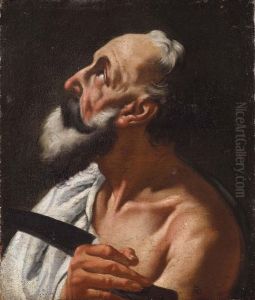Egidio Dall' Oglio Paintings
Egidio Dall'Oglio was an Italian painter, active during the Rococo period in the 18th century, primarily known for his fresco decorations in churches and palaces. Born in 1729 in Parma, Italy, he was part of a family of artists, with his father being the painter Paolo Dall'Oglio. Egidio's work is often characterized by its dynamic compositions, elegant figures, and a light, vibrant color palette that reflects the ornamental and theatrical style of Rococo art.
Dall'Oglio trained under his father and was much influenced by the works of other Parma-based artists such as Giovanni Battista Tiepolo, who was a leading figure in 18th-century Italian art and known for his grand frescoes. Egidio's early exposure to such influences helped to shape his artistic style, which combined the local artistic traditions with the broader European trends of the time.
Throughout his career, Dall'Oglio worked on various significant projects. He was particularly active in decorating religious buildings, where his frescoes often depicted scenes from the Bible and the lives of the saints, executed with a sense of movement and drama that was typical of the Rococo period. His work can be seen in several churches in Parma and its surroundings, where he contributed to the rich artistic heritage of the region.
Egidio Dall'Oglio's work was well received in his time, and he was recognized for his ability to create a sense of grandeur and festivity in his paintings. However, his career was relatively short-lived; he died in 1784 at the age of 55. Despite his early death, Dall'Oglio left behind a body of work that continues to be appreciated for its artistic quality and contribution to the Rococo movement in Northern Italy. His legacy is also carried on through the works of other artists in the region who were influenced by his style and techniques.
